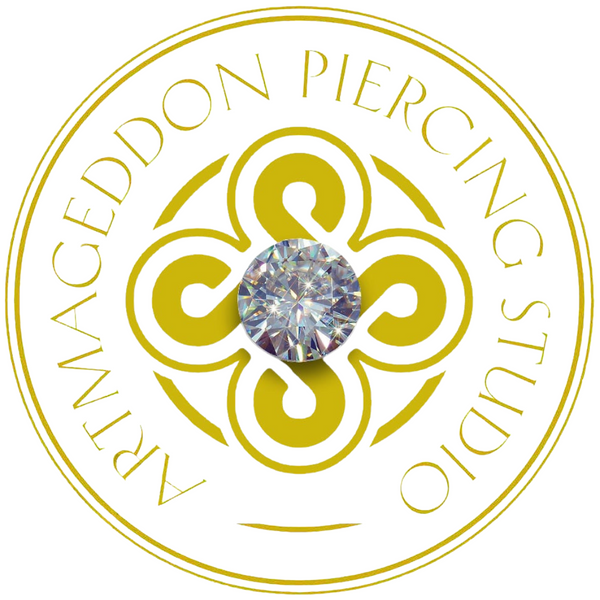Piercing Guns vs Needle Piercings
Why choosing the right method matters for your safety, comfort, and long-term healing
When it comes to getting a piercing, the method used matters far more than most people realise. While piercing guns are commonly used in high street settings for speed and convenience, they come with serious drawbacks, many of which are not explained at the time of the appointment.
Professional body piercers overwhelmingly favour the use of needles, and with good reason. Here's a clear comparison to help you make an informed choice.
1. Tissue Damage: Crushing vs Clean Cutting
Piercing guns use blunt force to push a dull stud through the skin or cartilage. This process doesn’t create space for the jewellery — it tears or crushes the tissue to make room. This can lead to:
Increased swelling
A greater risk of scarring, lumps, infection and poorly fitting jewellery
Potential cartilage trauma (including cracking or long-term deformity)
By contrast, a piercing needle is sharp, hollow, and designed specifically to pierce tissue cleanly. The needle removes a tiny core of tissue and creates a precise channel for the jewellery, causing:
Minimal trauma to the surrounding area
Less swelling and discomfort
Cleaner, faster healing
2. Sterility and Hygiene Standards
Piercing guns and piercing systems cannot be properly sterilised in an autoclave (the industry standard for medical-grade sterilisation). Even if they use disposable cartridges, the gun housing itself often contacts the client’s skin and can be contaminated with blood or fluids.
Professional piercers, on the other hand:
Use sterile, single-use needles for every piercing
Wear sterile gloves (not just general-use nitrile gloves)
Use an autoclave to sterilise any reusable equipment
Clean and prep the piercing area using aseptic techniques
This significantly reduces the risk of infection, cross-contamination, and long-term complications.
3. Training and Skill
Piercing guns are often used by retail employees with minimal training, in some cases just a short video, a printed manual, or shadowing another employee. They are not typically taught anatomy, hygiene, or how to identify contraindications (such as poor placement or unsuitable anatomy).
A professional piercer usually undergoes extensive training and continuous education at conventions held yearly by the UKAPP (UK Association of Professional Piercers.) They understand:
Skin and cartilage structure
Safe and accurate jewellery placement
Sterile technique and cross-contamination prevention
Aftercare, troubleshooting, and healing support
They are also trained to say no when a piercing is not suitable, prioritising your wellbeing over making a sale.
4. Jewellery Quality and Fit
Most gun piercings are done using pre-loaded, one-size-fits-all studs, which are often:
Too short to allow for initial swelling
Made from low-quality materials like mystery metal or base-level steel
Designed more for convenience than comfort or healing
Professional piercers use jewellery made from implant-grade materials, including:
Implant-grade titanium (Ti-6AL-4V ELI ASTM F136) - hypoallergenic and corrosion-resistant
14k or 18k solid gold - mirror-polished and nickel-free
Proper sizing to accommodate swelling and promote long-term comfort
The difference in healing, comfort, and safety is substantial.
5. Placement Accuracy and Long-Term Results
Piercing guns offer little to no control over placement — once you press the trigger, there’s no fine adjustment. This can lead to:
Uneven, asymmetrical placement
Improper angles that lead to irritation or rejection
Difficulties with future jewellery changes or upgrades
The gun (system) frequently jams, and has to be manually released from the ear, causing even more trauma, both physically and emotionally, and greatly increasing the chances of infection and embedding.
Needle piercings are placed with precision, marked, measured, and angled to suit your anatomy and preferences. This means:
Better symmetry
Reduced irritation
Long-term viability and aesthetics
6. Healing and Aftercare Support
Stud gun piercings are frequently offered with little to no aftercare guidance, or outdated advice like rotating the jewellery or using alcohol-based cleaners (both of which hinder healing and can cause long term damage to the skin). Follow-up appointments are rarely offered, and should you have a problem, they are rarely trained to recognise issues, or advise on them.
Professional studios:
Provide written aftercare guidance
Recommend sterile saline and modern healing techniques
Offer downsizing services and healing check-ins
Are available for troubleshooting, even months later
You should never feel left to figure it out on your own.
The Bottom Line: Choose Professional, Choose Safe
While piercing guns may seem quick and convenient, they come with significant trade-offs in terms of:
Safety
Hygiene
Comfort
Privacy
Accuracy
Jewellery quality
Healing time
Professional piercers who use needles can offer a safer, cleaner, more comfortable experience, and they’re trained to help you make decisions based on anatomy, not impulse.
If in Doubt, Ask Questions
Before getting pierced, ask:
Will a single-use needle be used?
Is the jewellery implant-grade titanium or solid gold?
Do they use an autoclave to sterilise tools?
Is there a private piercing room?
Do they offer follow-up care?
If you’re not getting clear answers, or if the response makes you feel rushed or uncomfortable, it’s perfectly okay to walk away and find a studio that treats your piercing like the long-term investment it is.
At Artmageddon, we prioritise safety, skill, and honesty over speed or shortcuts. Whether it’s your first lobe or your latest curation, we’ll guide you with care and professionalism every step of the way.
